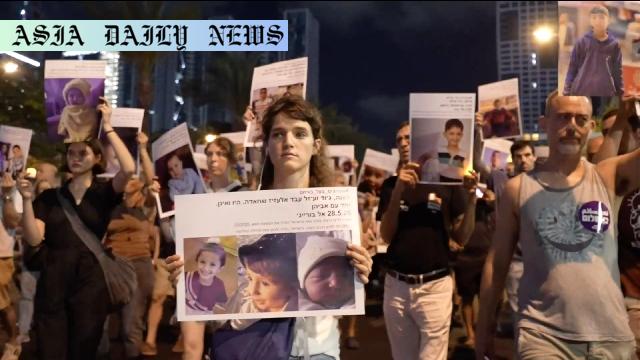Gaza Child Deaths: Demonstrators in Israel call for a ceasefire amid reports of over 17,000 Palestinian children killed.
Gaza Child Deaths: Over 17,000 children reported killed since October 2023.
Tel Aviv protesters urge ceasefire to prevent further fatalities.
Human rights activist Alma Beck highlights need for societal change in Israel.
Violence continues with more airstrikes on Gaza refugee camps.

Introduction: The Unfolding Tragedy in Gaza
The ongoing conflict in the Gaza Strip has seen an alarming increase in civilian casualties, with children bearing the brunt of the violence. Reports indicate that more than 17,000 children have lost their lives since October 2023 due to Israeli airstrikes. This tragic figure has provoked outrage and dismay among various communities, including within Israel itself. On Saturday, approximately 1,000 demonstrators gathered in Tel Aviv to create awareness about the staggering toll of children killed. The protesters demanded a ceasefire to prevent additional fatalities, holding up posters and photos that bore the names and faces of young victims. Their demands represent an urgent plea that the world can no longer ignore.
The Role of Activism and Public Awareness
The protest was not a one-time event but part of a growing movement led by individuals like human rights activist Alma Beck. Beck has been instrumental in organizing rallies to shed light on what she describes as a “genocide” happening in Gaza. According to her, these protests aim to generate awareness among Israeli citizens, urging them to confront the reality of Palestinian fatalities. The demonstrations began modestly in March 2023, with only about 20 participants. Since then, public involvement has grown significantly, reflecting a shift in awareness and urgency among the Israeli public. Beck’s mission, however, is far from over, as she continues to advocate for transformative changes within Israeli society to address the humanitarian crisis in Gaza.
The Impact of Strikes on Gaza Civilians
While activism within Israel gains momentum, the reality in Gaza grows increasingly bleak. The conflict has devastated infrastructure, displaced thousands, and led to immense human suffering. On Sunday, Israeli airstrikes targeted a water distribution point in Nuseirat refugee camp, killing ten individuals, including six children. Such attacks have exacerbated the humanitarian crisis, leaving survivors without access to basic necessities like clean water and shelter. Health officials within Gaza have described the situation as dire, with hospitals overwhelmed and resources stretched to their limits. The international community has yet to find a resolution that addresses both immediate needs and long-term solutions.
International Response and Accountability
The high number of child casualties in Gaza has caught the attention of global human rights organizations and foreign governments. Calls for a ceasefire have intensified as disturbing statistics and images circulate worldwide. Some nations have urged Israel to reconsider its military strategies, emphasizing the need to prioritize civilian safety. Palestinian media outlets have reported extensively on the ongoing violence, drawing attention to the disproportionate impact on vulnerable populations. Despite these efforts, achieving accountability and fostering lasting peace remains a complex challenge, compounded by decades of mistrust and political tensions.
The Path Forward: A Call for Peace
As demonstrators and activists continue their efforts, the path forward requires a commitment to dialogue and mutual understanding. Ending the cycle of violence in Gaza demands more than immediate ceasefires; it requires addressing the root causes of the conflict and fostering coexistence between Israelis and Palestinians. Grassroots movements, like the one led by Alma Beck, play a critical role in bridging gaps and humanizing the plight of those affected. Their efforts underscore the fundamental truth that every life, regardless of nationality or ethnicity, holds inherent value. While the challenges are immense, hope lies in the potential for change driven by empathy and shared humanity.



Commentary
The Harrowing Toll of Conflict on Children
The statistics emerging from the Gaza Strip are staggering and deeply troubling. The reported deaths of over 17,000 children should serve as a wake-up call to the international community. These young lives are the most innocent victims of a conflict that they neither created nor understand. Every child’s name, every photograph held up by protesters in Tel Aviv, represents a shattered family, a lost future, and immeasurable grief. It is a stark reminder of the human cost of prolonged warfare and the urgent need for resolution.
Hope in Grassroots Activism
The growing activism within Israel is a glimmer of hope amid the darkness of the ongoing crisis. The efforts of activists like Alma Beck demonstrate that empathy and awareness can transcend borders and narratives. Her commitment to highlighting the suffering in Gaza serves as an inspiration for others to speak up and demand change. The fact that the demonstrator turnout increased from just 20 to 1,000 reflects a hunger for peace and justice within Israeli society. These acts of courage and compassion pave the way for broader dialogue and understanding.
The Responsibility of the Global Community
While local activism is critical, the responsibility to address this crisis extends beyond Israel and Palestine. International organizations and leaders must act decisively to broker peace and provide humanitarian relief. Allowing the humanitarian tragedy in Gaza to continue unchecked would be a failure on a global scale. The voices calling for a ceasefire and accountability should not be ignored. Only with collective effort and a commitment to long-term solutions can the cycle of violence and suffering be broken.